The history of plantation life in Jamaica is a disturbing and complex mosaic filled with stories of resilience, brutality, adaptation and triumph.
To comprehend the lives of enslaved Africans in this deplorable era, we delve into the intricacies of their working conditions, diet and community structure. Understanding these aspects of daily life illuminates a dark chapter in history and exemplifies the strength of the human spirit when faced with impossible adversity.
Surviving Unbearable Living Conditions
The Impact of Tropical and Imported Diseases
The Carribean Islands witnessed the arrival of enslaved Africans in the 17th century. Their existence was marked by extreme hardship. Unrestrained abuse and rampant disease, combined with gruelling working conditions created a heinous reality. The number of deaths consistently surpassed births, contributing to a brutal and short-lived existence. (Bussa and Christmas Rebellions, 2011)
Slaves in Jamaica grappled with severe health challenges exacerbated by the prevalence of tropical and imported diseases. The harsh tropical climate created a breeding ground for diseases like yellow fever and malaria, posing a constant threat to the well-being of enslaved individuals (Jamaica | History, Population, Flag, Map, Capital, & Facts, 2024). The introduction of new diseases by European colonizers further intensified the health risks faced by the population (Slavery in the Caribbean, 2024.)
The volatile combination of tropical diseases and harsh working conditions resulted in a life expectancy that was consistently low for the enslaved population. According to the Jamaican Embassy, “The life expectancy of a West African slave in Jamaica was 7 years.” (Earle, 2013)
The following is a chart cataloguing the causes of death the African people who were enslaved at Worthy Park Plantation in Jamaica from 1783-1838.
Figure 1
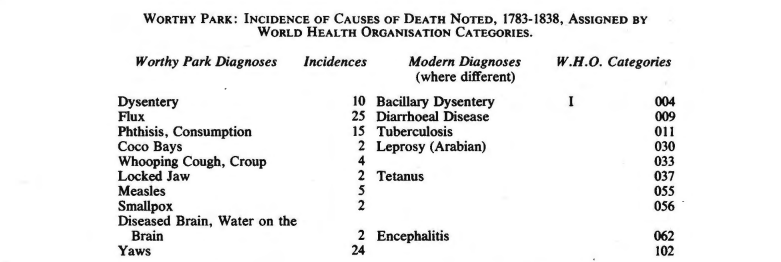
Below is a chart representing the illnesses they were treated for during that time.
Worthy Park is not the plantation Sam Sharpe lived on but as the medical records for Croyden Estate were not available, this chart gives an overview of the abuse and health issues endured by enslaved people on Jamaican Sugar Plantations during this time period. It also illustrates the high suicide rates brought on by the deplorable conditions and treatment enslaved people received.
Figure 2
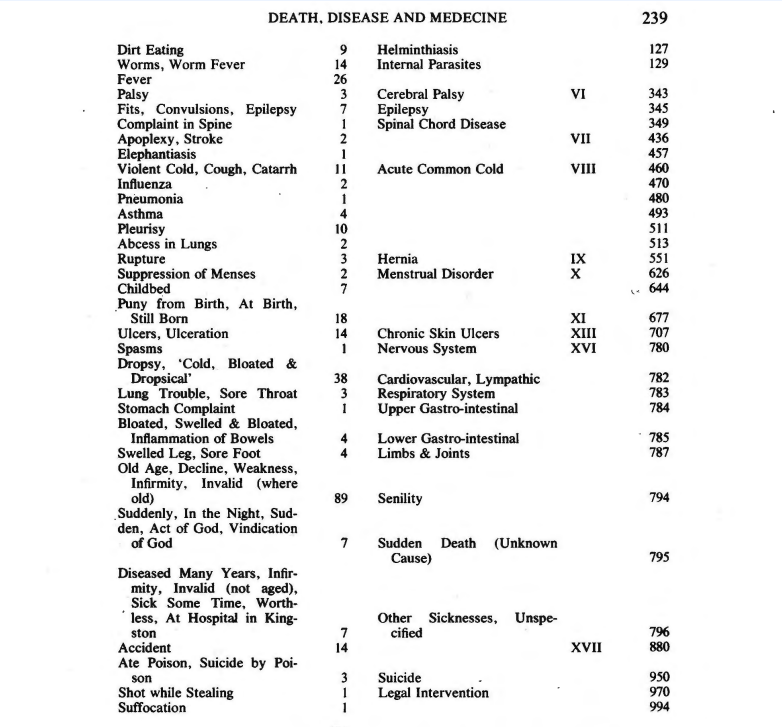
1767-1838 Michael CRATON file:///C:/Users/39Pancakes/Downloads/admin,+hssh9n18_craton%20(5).pdf
Dangerous Work Environments
The gruelling nature of plantation labour intensified the brutal living conditions endured by the enslaved population.
On Jamaican plantations, enslaved Africans faced arduous work schedules, often labouring around 12 hours per day from 6 a.m. to 6 p.m., and sometimes even longer hours during intense periods like ‘crop time’ on sugar plantations. These extended work hours during critical phases, such as cane harvesting, demonstrate the relentless demands placed on the enslaved individuals, with limited time for rest. (The Slavery Experience, 2012)
The daily routine included brief breaks for breakfast and lunch, providing only a short respite from the demanding tasks assigned to them. Additionally, after completing their regular work, enslaved individuals were compelled to perform extra duties like disposing of trash in cattle pens or carrying grass for the planters’ horses (Slavery in the Caribbean, 2024).
“Working in sugar was especially harsh… The toughest work – planting, manuring, and cane-cutting – fell to the strongest and healthiest… Even the very young and the old were put to work: driving away birds, cleaning and guarding. From their early years until the onset of old age and infirmity, sugar slaves had to work.” (Bussa and Christmas Rebellions, 2011)
Enduring Physical and Emotional Abuse
Systemic Violence
The lives of Jamaican sugar plantation slaves were marred by vicious mistreatment, with the lash serving as a haunting symbol and a constant soundscape in their daily existence. Slaves were whipped for speaking out or breaking the rules. Physical punishment was employed to coerce labour and was shockingly commonplace and wielded frequently by overseers for various offences.
“On plantations as on the slave ships, violence was the lubricant liberally doled out by planters and their managers to secure the obedience and the labour of their enslaved labour force.” (Bussa and Christmas Rebellions, 2011)
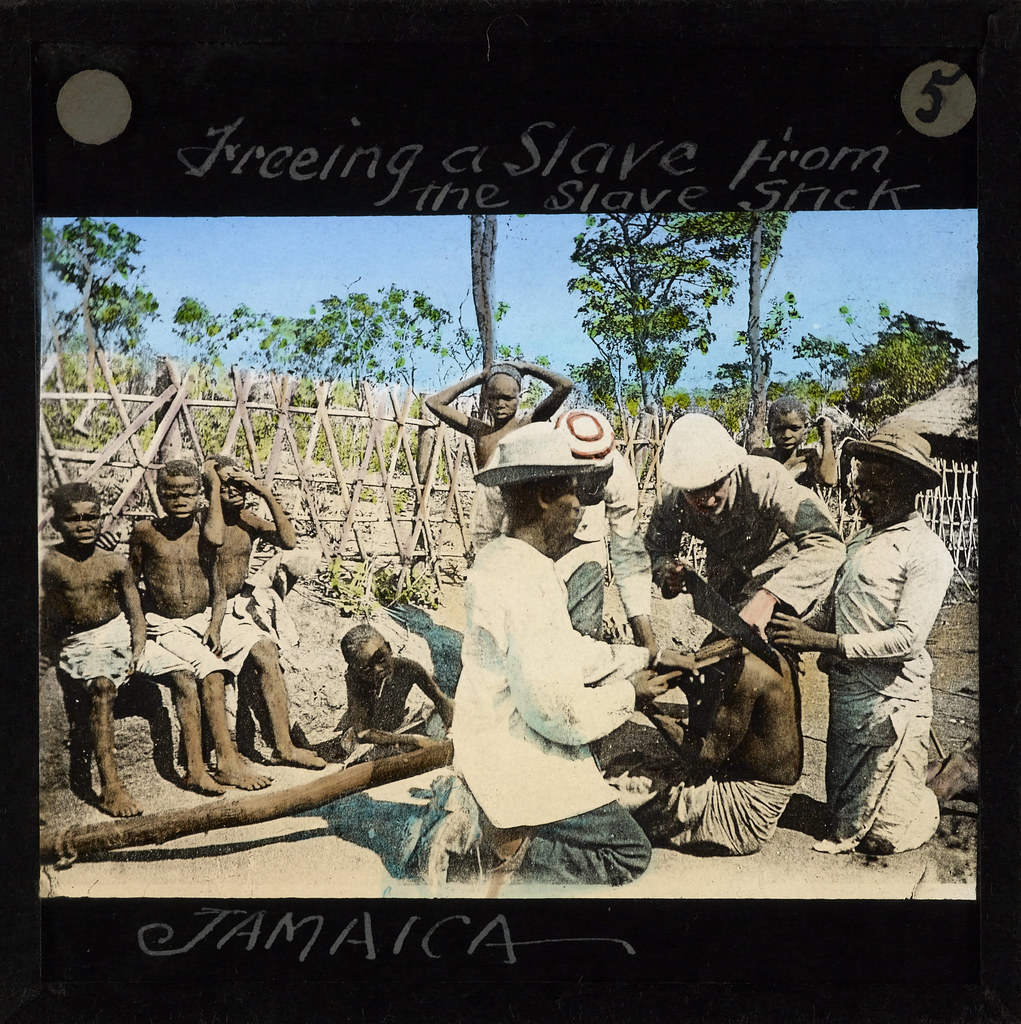
“Forked wooden sticks or yokes were used to tie captives together in a line or coffle when they were marched to the coast. The forked end was placed around a captive’s neck and the iron bar put across to hold it in place. The other end would be tied to another yoke, or the person behind would have to pick it up for the group to move forward.” (Yoke, n.d.)
Familial Separation and Forced Displacement
Beyond physical abuse, plantation slaves endured profound personal violations, including separation of family members and forced relocation. Owners could sell slaves abruptly, severing familial and communal bonds with sudden moves to unfamiliar and distant locations. This aspect of plantation life generated deep resentment and sorrow among the enslaved. (Bussa and Christmas Rebellions, 2011)
Sexual Exploitation
Sexual exploitation was another dehumanizing aspect of plantation life, with both male and female slaves enduring predatory advances from their masters. This widespread abuse affected workers of all ages and relationships, inflicting deep humiliation and lasting trauma. Perpetrators, often disregarding familial ties, caused profound harm to the women they exploited. (Bussa and Christmas Rebellions, 2011)
Diet and Food Production
Importation vs. Local Food Production
While the volcanic soils of the islands were fertile, the relentless pursuit of profits from sugar cultivation led plantation owners to prioritize importing food from North America rather than utilizing available land for local food production.
The meagre weekly rations provided to the workers were a stark reflection of the economic priorities of plantation owners, leading to widespread malnutrition and starvation within the enslaved population. The allocation of minimal provisions, driven by profit motives, resulted in diets lacking essential nutrients, exacerbating the already atrocious living conditions and resulting in increased health problems among the enslaved. (Slavery in the Caribbean, 2024)
Supplementing Diets with Wild Foods
In their quest for sustenance, the enslaved Africans exhibited remarkable resourcefulness by supplementing their scanty rations with Breadfruit and other wild foods available in the surrounding environment. This strategic approach demonstrated the enslaved population’s resilience in adapting to the challenges posed by inadequate diets.

They foraged for edible plants, fruits, and small game in the nearby natural habitats, utilizing their knowledge of the local environment to identify nourishing alternatives. This practice not only attested to their survival instincts but also reflected a deep understanding of the ecological resources in the area.
The inclusion of wild foods into the diet played a crucial role in diversifying nutritional intake. Enslaved individuals sought out various sources of sustenance, such as edible roots, fruits, and small animals, to address the nutritional gaps left by their inadequate provisions.
By adapting to the environment and creatively incorporating wild foods into their diets, the enslaved demonstrated an extraordinary ability to sustain themselves despite the systemic hardships they endured. This resourceful approach not only spoke to their ingenuity but also highlighted their determination to mitigate the impact of nutritional inadequacies on their well-being.
“I have known some of them to be fond of eating grasshoppers, or locusts; others will wrap up cane rats, in bonano [banana] leaves, and roast them in wood embers”. (Smith 1745, 232).” (Slavery in the Caribbean, 2024)
Provision Grounds and Gardens
Workers also cultivated provision grounds and small gardens to supplement their diets. These grounds, often allocated by plantation owners, provided a space for the enslaved to grow their own food, diversifying their nutritional intake beyond the meagre rations provided by the plantation.
In these provision grounds, a variety of crops were planted including root vegetables, tubers, and leafy greens. This cultivation not only added nutritional diversity to their diets but also served as a form of self-sufficiency. (Slavery in the Caribbean, 2024)
The Villages of the Enslaved
Organization and Layout
The villages of the enslaved workers were strategically positioned in proximity to the main houses and plantation works.
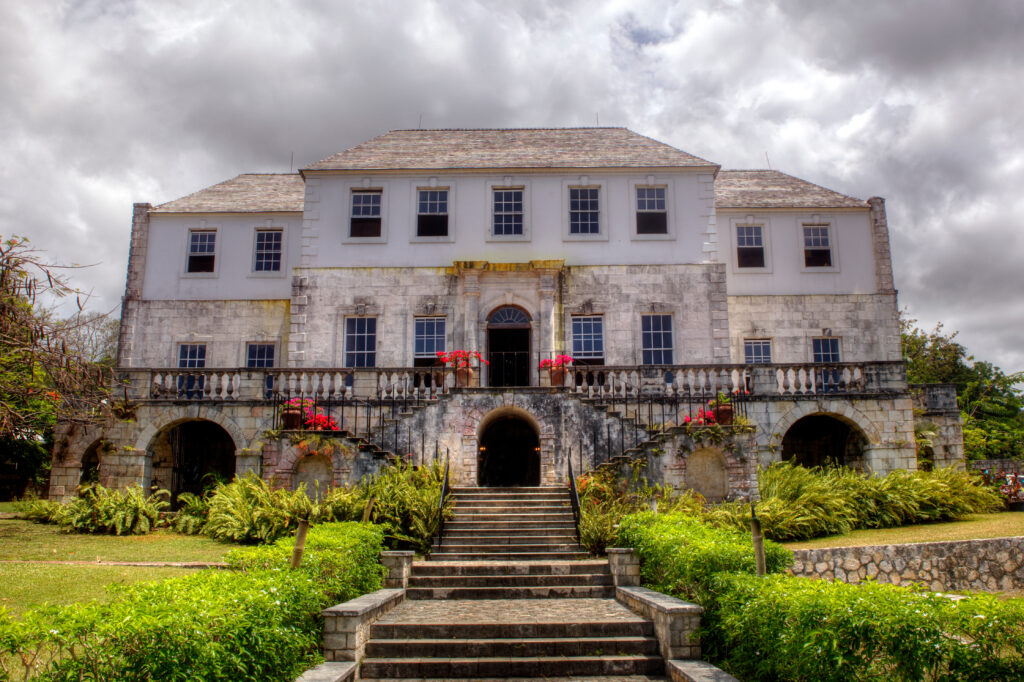
According to historical accounts, including observations from Reverend William Smith in the mid-18th century, these villages were often situated near to the main house, allowing owners or managers to supervise the enslaved workforce easily.
This arrangement reinforced the social hierarchy, emphasizing the inferior status of the enslaved population. To further reinforce the dehumanization of the enslaved, the location choice also considered prevailing winds; villages were usually downwind from the main house, ensuring that undesirable odours did not reach the estate’s core areas. (Slavery in the Caribbean, 2024)
Housing
Slave houses on Jamaican plantations possessed physical characteristics that mirrored the challenging living conditions of the workers.
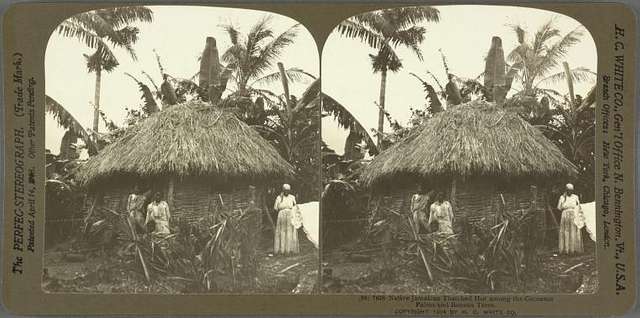
Title: Native Jamaican Thatched Hut Among the Coconut Palms and Banana Trees. Image Source: New York Public Library Digital Archives https://nypl.getarchive.net/media/native-jamaican-thatched-hut-among-the-cocoanut-palms-and-banana-trees-c1bc01 CC Licence 1.0
These dwellings were typically composed of posts in the ground, with thatched roofs covering the sides and top, and boarded partitions. The construction of these houses was basic, resembling huts with a single storey, and the thatching material often consisted of cane trash. In stark contrast to the opulence of plantation houses, the design prioritized functionality over elaborate aesthetics, reflecting the utilitarian nature of these structures.
In the late 18th century, improvements in housing for enslaved workers were observed. Some Jamaican planters reorganized villages into regularly planned layouts, incorporating stone or shingled houses for the workforce.
Despite these changes, the majority of slave houses maintained a simple and practical design, with posts, thatch, and basic interiors.
These physical features represent the severe conditions in which enslaved Africans lived on Jamaican plantations. The structures, while showing some evolution over time, continued to reflect the limited resources available to the enslaved population. (Slavery in the Caribbean, 2024)
In Perspective
Examining the daily lives of enslaved plantation workers in Jamaica offers valuable insights into their struggles while providing a meaningful lens through which we can comprehend the significance of events like Sam Sharpe’s Christmas Rebellion
Understanding the context of plantation life enhances our appreciation for the strength and determination exhibited by individuals like Sharpe. It illuminates the factors that fueled the rebellion, showcasing the tenacity of those who sought justice and freedom in the face of unimaginable adversity.
This historical exploration not only informs us about the past but also connects the dots to pivotal moments like the Christmas Rebellion, reminding us of the importance of learning from the atrocities committed in our shared history.